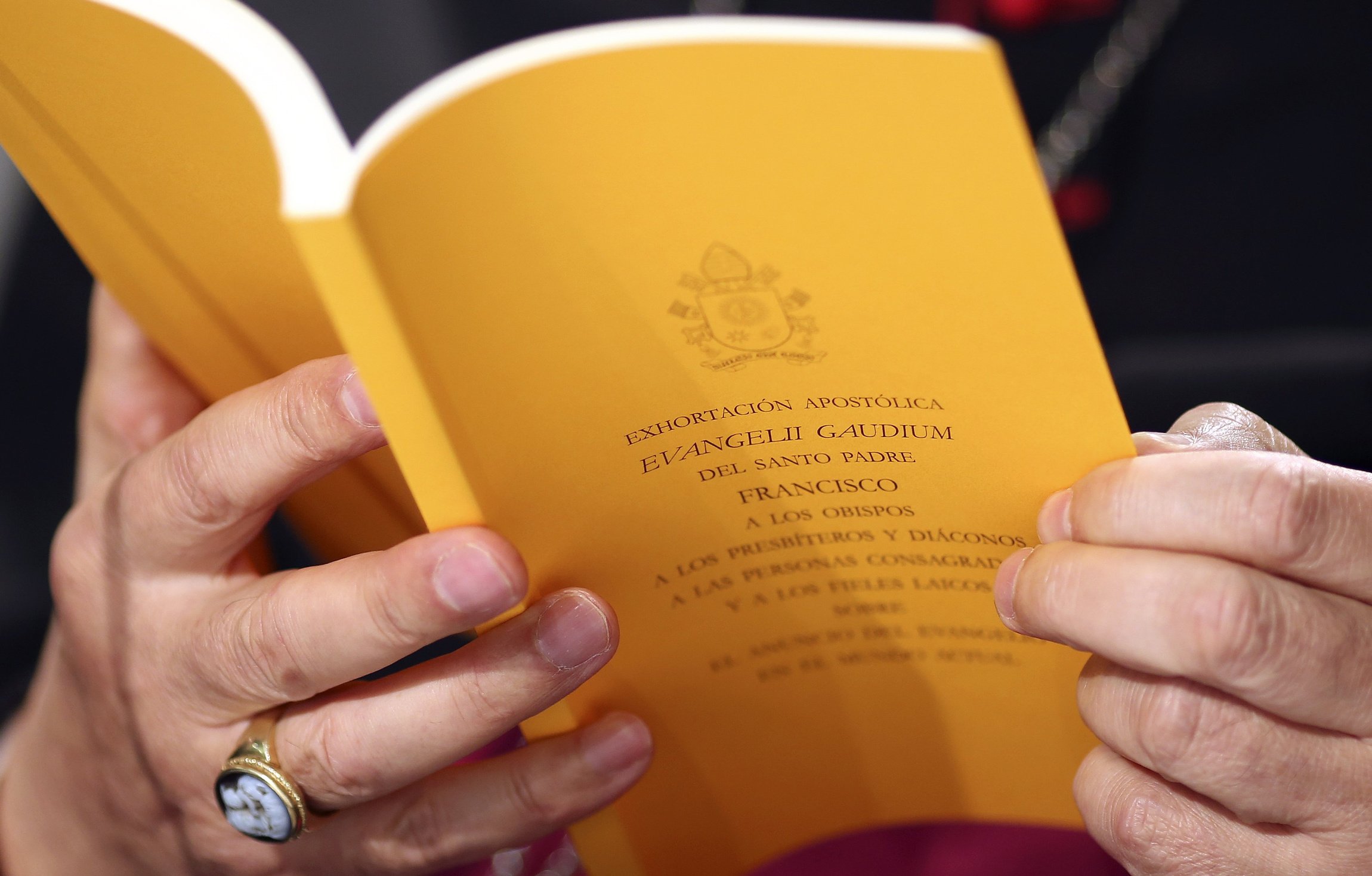(OSV News) — “The joy of the Gospel fills the hearts and lives of all who encounter Jesus. Those who accept his offer of salvation are set free from sin, sorrow, inner emptiness and loneliness. With Christ joy is constantly born anew,” Pope Francis wrote in the opening of “Evangelii Gaudium,” a 2013 document many have interpreted as the new pope’s presentation of his vision for the contemporary church.
Released 10 years ago Nov. 24, the document’s message is as relevant as ever, several theologians and evangelization experts told OSV News.
“Jesus is the son of God who took flesh to be with us. … It’s this reality that I think Pope Francis has in a deep, deep level in his personal life, and it does radiate out through the document,” said Curtis Martin, founder of the Fellowship of Catholic University Students, or FOCUS, a Denver-based organization for evangelizing college students.
“Evangelii Gaudium” — subtitled “On the Proclamation of the Gospel in Today’s World” — is widely considered Pope Francis’ first major document. The encyclical “Lumen Fidei,” released five months earlier in June, was signed by Pope Francis but largely drafted by Pope Benedict XVI before his February 2013 resignation.
The title of “Evangelii Gaudium” comes from the Latin translation of its opening phrase: “The Joy of the Gospel.”
“I dream of a ‘missionary option,’ that is, a missionary impulse capable of transforming everything, so that the Church’s customs, ways of doing things, times and schedules, language and structures can be suitably channeled for the evangelization of today’s world rather than for her self-preservation,” Pope Francis wrote.
The apostolic exhortation followed the October 2012 XIII Ordinary General Assembly of the Synod of Bishops on the new evangelization, over which Pope Benedict presided. Its publication also coincided with the end of the Year of Faith.
Martin was among the lay observers participating in the synod. Notably, Cardinal Jorge Bergoglio — the future Pope Francis — was not among its bishop members, but “Evangelii Gaudium,” while not labeled a “post-synodal” exhortation, reflects both the conversation at the synod as well as Pope Francis’ vision for the church, Martin said.
“It is my favorite of Pope Francis’ documents,” he said, noting FOCUS asks its campus missionaries to read the document — which runs about 50,000 words — “cover to cover.”
“The theme of the joy of the Gospel is so, so critical,” Martin said. “My experience is that Catholics know the Gospel, they know that Jesus died for our sins, they know that he rose from the dead. They know that. But it doesn’t necessarily become the central part of their lives.
“And the whole point of the document was, if Jesus becomes the central reality, central person, of your life, you will begin to experience joy,” Martin continued, “because when you allow Jesus in the center of your life, you also bring the Father and the Holy Spirit. And the fruits of the Spirit are love and joy and peace, patience, kindness, goodness, gentleness. … Joy is the one gift that you can’t get away from. Everyone wants to be joyful.”
The document emphasizes the centrality of the “kerygma,” the proclamation of the Gospel message. “On the lips of the catechist the first proclamation must ring out over and over: ‘Jesus Christ loves you; he gave his life to save you; and now he is living at your side every day to enlighten, strengthen and free you,'” Pope Francis wrote.
Organized into five chapters, “Evangelii Gaudium” is wide ranging, with comments on the poor and consumerism, welcoming Muslims and the importance of beauty.
It ends with a reflection on Mary, with Pope Francis noting, “There is a Marian ‘style’ to the Church’s work of evangelization. Whenever we look to Mary, we come to believe once again in the revolutionary nature of love and tenderness.” It closes with a six-stanza prayer for Mary’s intercession, culminating in “Mother of the living Gospel, wellspring of happiness for God’s little ones, pray for us.”
Massimo Faggioli, a professor of theology and religious studies at Villanova University in Philadelphia, who studies Pope Francis, described “Evangelli Gaudium” in 2013 as “the manifesto of Francis.” He told OSV News that it has stood the test of time.
“What stood out to me 10 years ago was … a natural instinct to reappropriate, in a very open way, the legacy of the Second Vatican Council,” he said. “You have this document of this new pope, who says basically, Vatican II was good, but we haven’t implemented everything that Vatican II was about.”
“Evangelii Gaudium” expressed the “idea that the church needs to be credible and to be visible and to be active in this world,” Faggioli said. “It’s not a church locked in the sanctuary.”
Kelly Wahlquist, founder of Women in the New Evangelization, considers “Evangelii Gaudium” a seminal document for the Minnesota-based women’s ministry, which was beginning to take shape in 2013.
“It was really the bridge that brought us from this concept of what is the Lord asking us to do as women, because the Holy Father had called for a deeper, more profound theology of women, and it … brought us to Women in the New Evangelization, because what we were talking about was the importance of evangelizing from heart to heart,” she said.
The document “talks about that missionary joy — that it’s something that brings people in,” she said. “It’s not just a happiness, not a human happiness — like you’re having a nice glass of wine and a big steak, and you’re happy for a little bit — but it’s a joy where you recognize they have something.”
The document is more important today than ever, Wahlquist said, “because of what we’re living in around us can seem so joyless.”
But, she said, “I see that the Gospel has been proclaimed and that it’s bearing fruit, and you know that’s a result of joy.”
Maria Wiering is senior writer for OSV News.




